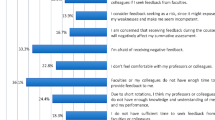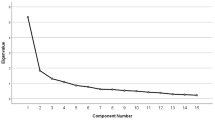Abstract
The authors tested the effect of preceptor feedback to residents of patients’ ratings of perceived art and technical quality of care on residents’ subsequent performances. New ambulatory patients were asked to complete questionnaires measuring satisfaction with physician behavior during initial encounters. Sixty-eight residents were evaluated by 424 patients over a six-month period. Continuing residents with the lowest scores were assigned to a feedback or a non-feedback group. Residents in the feedback group were individually shown their mean scores on each item, as well as scores for all residents, and were then advised of physicians’ behaviors that could increase patient satisfaction. During a subsequent six-month survey of new patients, scores in the feedback group improved more than those in the non-feedback group in art of care, technical quality, and total patient satisfaction (p<0.001).
Similar content being viewed by others
References
Carroll JG, Monroe J. Teaching medical interviewing: a critique of educational research and practice. J Med Educ 1979;54:498–500
Ware JE Jr, Davies-Avery A, Stewart AL. The measurement and meaning of patient satisfaction. Health Med Care Serv Rev 1978;1:2
Adamson TE, Gullion DS. Physician—patient communication and medical malpractice. Mobius 1984;4:33–7
Somers HM. The malpractice controversy and the quality of patient care. MMFQ/Health and Society 1977;95:193–231
Vaccarino JM. Malpractice: the problem in perspective. JAMA 1977;238:861–3
Linn LS, et al. A behavioral medicine course for postgraduate trainees in internal medicine. J Med Educ 1980;55:133–5
Gorlin R, Zucker HD. Physicians’ reactions to patients: a key to teaching humanistic medicine. N Engl J Med 1983;308:1059–63
Young LE. The broadly-based internist as the backbone of medical practice. In: Ingelfinger FJ, Ebert RB, Finland M, Relman AS (eds). Controversies in internal medicine II. Philadelphia, W. B. Saunders, 1974
Griner PF (ed). Training of the general internist. Different approaches. Arch Intern Med 1977;137:1291–8
Benson JA, Jr., Bollet AJ, Faber SJ, et al. Clinical competence in internal medicine. Ann Intern Med 1979;90:402–11
Benson JA Jr. Blank LL, Frankel EP. et al. Evaluation of humanistic qualities in the internist. Ann Intern Med 1983;99:720–4
Ende J, Feedback in clinical medical education. JAMA 1983;250:777–81
Feletti GI, Carney SL. Evaluating patients’ satisfaction with medical students interviewing skills. Med Educ 1984;18:15–20
Thompson JA, Anderson JL. Patient preferences and bedside manner. Med Educ 1982;16:17–21
Annon JS. The behavioral treatment of sexual problems. Vol. 1., brief therapy. Honolulu: Enabling Systems, 1974.
Linn LS, Cope DW, Leake B. The effect of gender and training of residents on satisfaction ratings by patients. J Med Educ 1984;59:964–6
Ware JE, Kane RL, Davies AR, Brook RH. The patient role in assessing medical care process. The Rand Corporation (in press)
Ware JE, Davies AR. Behavioral consequences of patient dissatisfaction. Evaluation and Program Planning 1983;6:291–7
Linn LS, Oye RK, Cope DW, DeMatteo MR. The use of nonphysician staff in evaluating physicians’ humanistic behavior. J Med Educ (submitted)
Linn LS. Factors associated with patient evaluation of health care. Milbank Mem Fund Q 1975;4:531–48
Shortell SM. Continuity of medical care: conceptualization and measurement. Med Care 1976;14:377
Woolley FR, Kane RL, Hughes CC, Wright DP. The effects of doctor—patient communication on satisfaction and outcome of care. Soc Sci Med 1978;12:123–8
Wasson JH, Sauvigne AE, Mogielnicki RP, et al. Continuity of outpatient medical care in elderly men: a randomized trial. JAMA 1984;252:2413–7
Author information
Authors and Affiliations
Additional information
Received from the Department of Medicine, UCLA Center for the Health Sciences, Los Angeles, California.
Supported by USPHS Grant #19157.
Rights and permissions
About this article
Cite this article
Cope, D.W., Linn, L.S., Leake, B.D. et al. Modification of residents’ behavior by preceptor feedback of patient satisfaction. J Gen Intern Med 1, 394–398 (1986). https://doi.org/10.1007/BF02596425
Published:
Issue Date:
DOI: https://doi.org/10.1007/BF02596425




